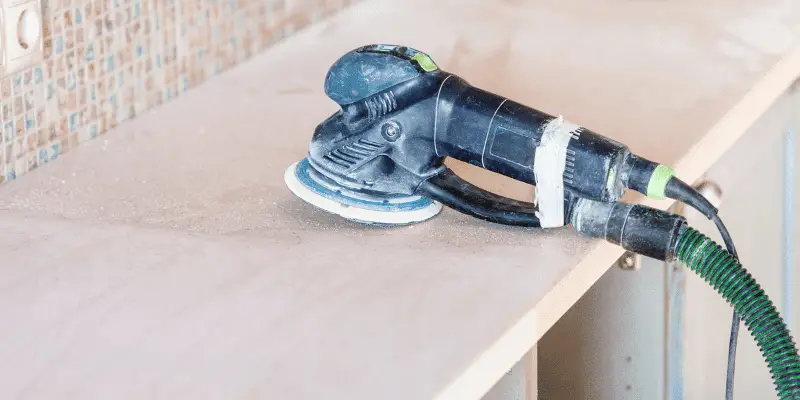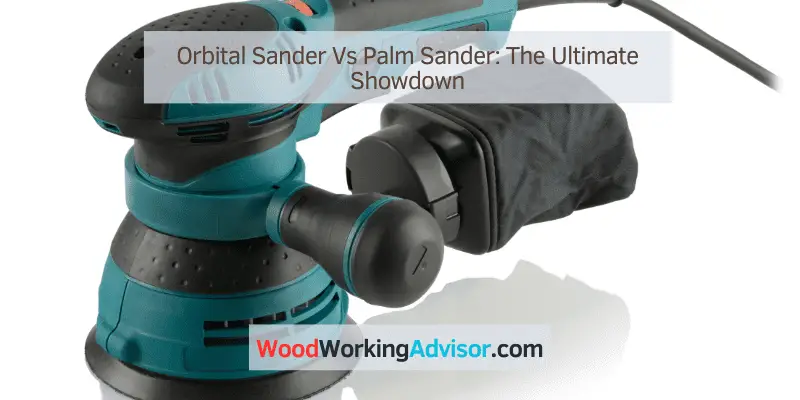Orbital sanders are best for large, flat surfaces, while palm sanders are for detail work and small spaces. When choosing between the two, consider your project’s needs and the surface you’re working on to ensure the best results.
Orbital sanders and palm sanders are both versatile tools, each with unique advantages. Understanding their differences will help you make an informed decision when selecting the most suitable sander for your projects. Whether you’re a professional woodworker or a DIY enthusiast, having the right sander can make a significant impact on the quality and efficiency of your work.
We’ll explore the characteristics, applications, and benefits of orbital sanders and palm sanders. By delving into the specifics of these tools, you can enhance your understanding of their roles and make a well-informed choice for your sanding needs.
Understanding The Differences
When it comes to woodworking or sanding tasks, choosing the right tool can make a significant difference in the quality of the final product. Two popular options for sanding are orbital sanders and palm sanders. Each type has its own unique features and functionalities. In this guide, we’ll delve into the differences between the two, allowing you to make an informed decision based on your sanding needs.
Types Of Sanders
Before comparing orbital sanders and palm sanders, it’s essential to understand their individual characteristics and intended uses.
- Orbital Sander: Also known as a finishing sander, an orbital sander features a round sanding pad that moves in small, circular orbits. This type of sander is ideal for smooth finishing and delicate surfaces.
- Palm Sander: A palm sander, on the other hand, is compact and lightweight, fitting snugly into the palm of the user’s hand. It utilizes a square or rectangular sanding pad and is suitable for small to medium-sized projects.
Mechanism And Functionality
Understanding the mechanism and functionality of each sander type can help in choosing the right tool for the task at hand.
- Orbital Sander Mechanism: The orbital sander operates by spinning the sanding pad in orbits while simultaneously moving it back and forth, resulting in a random sanding pattern. This prevents swirl marks and ensures uniform sanding.
- Palm Sander Mechanism: Palm sanders typically utilize a vibrating motion to sand the surface, providing a consistent and smooth finish. Some models also come with the option for detail sanding by using interchangeable pads.
Pros And Cons
The decision to choose between an orbital sander and a palm sander often boils down to understanding the pros and cons of each tool. Both tools have their unique advantages and limitations, and knowing these can help you make an informed choice depending on your project requirements. Let’s delve into the specific advantages and limitations of orbital sanders and palm sanders to help you decide which one best suits your needs.
Advantages Of Orbital Sander
Orbital sanders are prized for their versatility and ability to handle various sanding tasks. They are particularly useful for achieving a smooth, swirl-free finish due to their random orbital motion. Some of the key advantages of orbital sanders include:
- Efficient material removal
- Minimal risk of swirl marks
- Compatible with various sandpaper grits
- Easier to control
Advantages Of Palm Sander
Palm sanders are appreciated for their compact size and ease of use, especially in tight or intricate spaces. They offer specific benefits that make them a popular choice for certain sanding tasks, including:
- Lightweight and maneuverable
- Easy to handle for extended periods
- Ideal for small, detailed work
- Less aggressive on surfaces
Limitations Of Orbital Sander
While orbital sanders have several advantages, they also come with certain limitations that should be considered when choosing the right tool for your project. These limitations include:
- Less suitable for detailed work
- Require frequent sandpaper changes
- Can be more challenging to maneuver in tight spaces
- Louder and produce more vibration
Limitations Of Palm Sander
Palm sanders, despite their convenience, also have their own set of limitations that might impact their suitability for certain projects. Some of these limitations include:
- Slower material removal compared to orbital sanders
- More prone to leaving sanding marks
- Not as effective for heavy-duty sanding tasks
- May cause more fatigue during prolonged use
Best Uses For Each Sander
When it comes to refinishing woodwork, ensuring a smooth, even finish is key. Whether you’re a DIY enthusiast or a professional woodworker, choosing the right sander for the job can make all the difference. Both orbital sanders and palm sanders are popular choices and each has its own unique set of advantages. Understanding their ideal use cases can help you decide which sander is best suited for your specific project needs.
Ideal Projects For Orbital Sander
The orbital sander is renowned for its versatility and ability to handle a wide range of projects. Its random orbital motion is ideal for sanding large, flat surfaces as well as tackling curved or contoured woodwork. Here are some of the best use cases for an orbital sander:
- Sanding large tabletops and wooden floors
- Smoothing out rough lumber or boards
- Refinishing furniture with intricate detailing
- Fine sanding for a professional, polished finish
Ideal Projects For Palm Sander
The palm sander, with its compact size and precision, is specially designed for smaller, more detailed projects. Its unique triangular sanding pad allows for getting into tighter spaces and corners. Here are some of the ideal projects for a palm sander:
- Sanding stair treads, spindles, and handrails
- Refinishing cabinets, drawers, and other small furniture pieces
- Prepping surfaces for painting or staining
- Smoothing out edges and rounded profiles
Performance And Features
When comparing orbital sanders and palm sanders, it’s essential to consider their performance and features. Each type of sander has its strengths and weaknesses, making it crucial to understand the specific applications and requirements to determine which one is the best fit for your needs.
Sanding Speed And Power
Orbital sanders, known for their versatility, are designed to deliver power and speed, making them suitable for a wide range of sanding tasks. They feature a random orbital motion, which prevents swirl marks on the work surface and ensures a smooth finish. On the other hand, palm sanders are generally smaller and more lightweight, making them ideal for light to medium-duty sanding tasks. However, they may lack the power and sanding speed provided by orbital sanders. The choice between the two depends on the specific requirements of the project at hand.
Dust Collection And Control
Orbital sanders typically come equipped with efficient dust collection systems that minimize airborne particles and keep the work area clean. Many models feature dust bags or can be connected to a vacuum for enhanced dust control. Palm sanders, while generally less powerful, often have limited dust collection capabilities. This means that they may require more frequent cleaning and result in a messier working environment. For projects that prioritize cleanliness and air quality, the superior dust collection of orbital sanders may be a deciding factor.
Conclusion And Recommendations
In summarization, considering the task at hand, it is recommended that for small, detailed work, the palm sander is the most suitable choice. On the other hand, for larger, flat surfaces, the orbital sander is more efficient. It is advisable to choose the sander that best fits the specific project requirements.
Choosing The Right Sander
When deciding between an orbital sander and a palm sander, it’s essential to consider the specific needs of your project. If you are working on large, flat surfaces or require aggressive material removal, an orbital sander may be the better choice. On the other hand, for smaller projects, intricate detailing, or working in tight spaces, a palm sander is often the more suitable option.
Key Considerations For Purchase
Before making a purchase, evaluate the power, speed, and sanding motion of each type of sander to ensure it aligns with the demands of your projects. Additionally, consider the ergonomics of the sanders, as comfort and control are crucial for achieving high-quality results. Assess the availability of compatible sandpaper and accessories to optimize the functionality of your chosen sander for various applications.
Final Verdict: Which Sander Wins?
It’s essential to recognize that there is no one-size-fits-all answer when it comes to choosing between an orbital sander and a palm sander. The decision ultimately comes down to the specific tasks and projects at hand. However, for versatility and overall performance, an orbital sander often proves to be the more versatile and practical solution for a wide range of sanding applications

Frequently Asked Questions For Orbital Sander Vs Palm Sander
What Is The Main Difference Between An Orbital Sander And A Palm Sander?
An orbital sander moves in a circular motion, while a palm sander moves in a back-and-forth motion. The orbital sander is better for large, flat surfaces, while the palm sander is more versatile for different shapes and sizes of wood.
Which Type Of Sander Is Better For Fine Woodworking Projects?
For fine woodworking projects, a palm sander is recommended due to its ability to reach into small spaces and corners. It provides more control and precision, making it ideal for delicate finishing work on detailed woodwork.
Can I Use Both Sanders On The Same Project?
Yes, using both sanders on the same project can provide a more thorough and efficient sanding process. Start with the orbital sander to remove roughness and then use the palm sander for finer details and to smooth out any remaining imperfections for a professional finish.
Conclusion
The choice between an orbital sander and a palm sander depends on the specific project requirements. Understanding the distinct features and applications of each tool is crucial for achieving optimal results. Whether you prioritize speed or precision, both sanders offer unique advantages for different tasks.
Consider the specific needs of your project before selecting the most suitable sander for the job.



4 thoughts on “Orbital Sander Vs Palm Sander: The Ultimate Showdown”